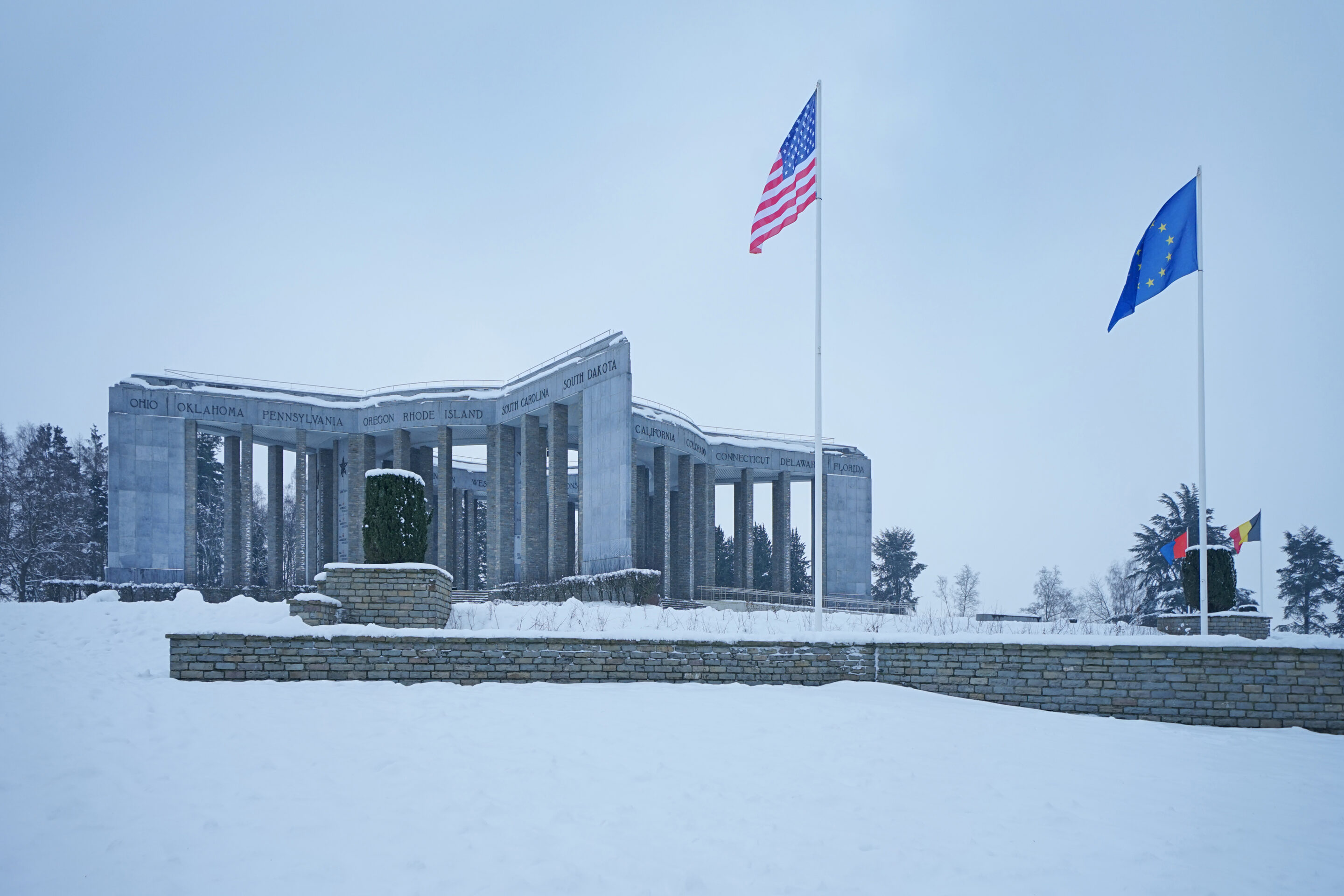Nestled deep in the Ardennes, Bastogne offers a vibrant blend of history, natural beauty and local charm. The picturesque forest enveloping Bastogne belies the bloody past. The town is synonymous with the Battle of the Bulge – or the Ardennes Offensive – which was the last throw of the dice by the Nazis against the Allies in the Second World War in late 1994.
Today, Bastogne is effectively a large, open-air museum. Military memorials and relics can be found across the town, from an M4 Sherman tank in Place McAuliffe to monuments commemorating soldiers and others who helped with the Allied effort. The tributes are moving and sombre, reflecting a grim history that still casts a shadow over the area today.
Bastogne was the base of the 101st Airborne Division during the brutal battle. At one point, the besieged acting commander, US Brigadier General Anthony McAuliffe, was handed a German ultimatum to surrender. In an episode that has gained almost mythical status, McAuliffe replied simply, “Nuts!”. The division held on until support arrived, and the Allies eventually repelled the Nazis.
The six-week battle lasted until January 25, 1945. It was the largest and bloodiest battle US soldiers fought during the Second World War, with around 90,000 killed, wounded or missing – the US Army describes it as “arguably the greatest battle in American military history.” More than one million soldiers took part in the campaign in all – the Germans suffered up to 105,000 casualties. The cold added to the gruelling conditions: temperatures fell to 15 C° to 20 C° below zero. The battle was memorably dramatised in Band of Brothers, the Stephen Spielberg/Tom Hanks 2001 mini-series, itself based on Stephen Ambrose’s non-fiction book.
Visitors should know that the town no longer has a train station. To reach Bastogne from Brussels, take a train to Liège, Marloie or Libramont and transfer by bus to complete the journey. The fastest routes are about three hours. Driving cuts travel time in half. Otherwise, a local guide can be hired via bastogne-tourisme.be, who can drive to various sites and embellish their history.

US Army tank in Bastogne
Military museums
The Bastogne War Museum, opened in 2014 and expanded in 2022, is the perfect place to begin a tour, giving an excellent overview of World War II, particularly the Battle of the Bulge, as heard through four historical characters. Interactive, digital displays and three multisensorial films with 3D stage settings give vivid information about the battle and period. A new immersive part of the museum’s extension called Generations45 follows in the footsteps of an American and a German veteran from the end of the war in 1945 to the fall of the Berlin Wall in 1989. It also has an engaging, 20-minute film. The museum entry fee includes access to Generations45, an audio guide and Le Bois Jacques battlefield (for €5 more, access to the Bastogne War Rooms is also included). Outside the museum are artfully painted old cars, a slice of the Berlin Wall and contemporary artworks. There is also a café overlooking the Mardasson Memorial and a shop with military-related items.
Le Bois Jacques – or Jack’s Wood – in the village of Foy some 4km from the Bastogne War Museum is where the most intense fighting occurred during the Siege of Bastogne. It still has visible foxholes that US soldiers dug and fought from in the harsh winter. An augmented reality mobile app drives home the horror of the place in a fenced area.
The Bastogne War Rooms opened in early 2024 in the former permanent headquarters of the 101st Airborne Division during the Battle of the Bulge. They take visitors back to that time with interactive displays and a high-tech re-enactment of the moment when McAuliffe said and wrote “Nuts!” in the cellar.
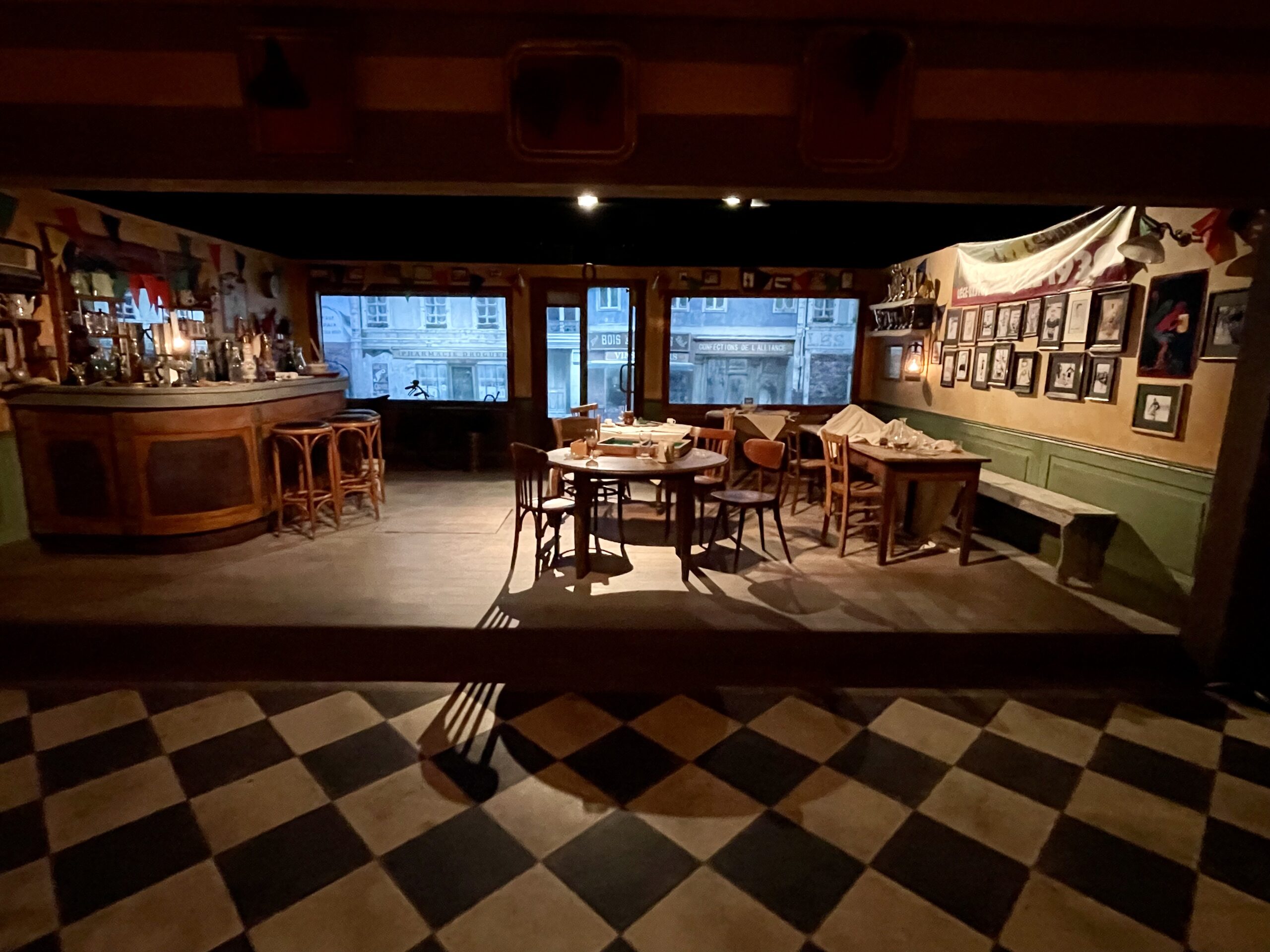
Film set in the Bastogne Museum
The restored Bastogne Barracks near the War Rooms house around 100 military vehicles, including tanks, and pieces of artillery and equipment from the primary countries involved in World War II. They include “Mechanised Warfare” and “Battle of the Bulge” (new in 2022) warehouses as well as a Vehicle Restoration Centre.
The 101st Airborne Museum in a former German military officers’ mess and underground shelter recounts the Battle of the Bulge from the perspective of the US paratroopers. It includes a bombing simulator, dioramas, historical videos, personal stories and many artefacts.
Memorials
While there are many memorials in Bastogne, here are those not to miss.
Mardasson Memorial is a huge, star-shaped monument next to the Bastogne War Museum that honours the tens of thousands of American soldiers who were killed or wounded in the Battle of the Bulge. A stone in its centre has inscribed in Latin "The Belgian people remember their American Liberators." On its walls are engravings of every US military unit involved, each US state and the story of the battle. Inaugurated in 1950 and restored before the 75th anniversary of the battle in 2019, the temple-like structure was designed by Belgian architect Georges Dedoyard. Its rooftop can be accessed via a spiral staircase, but it is currently closed due to restoration. A crypt below the esplanade displays a triptych of colourful mosaics representing Catholic, Protestant and Jewish religions. At the foot of the pathway leading to the memorial is a stone sculpture of a screaming eagle, the emblem of the 101st Airborne Division.

Bastogne, January 18 1945
On the road from the Bastogne War Museum to Le Bois Jacques is the 101st Airborne Division’s Company E Memorial. It lists the names of company men who died in the area and tells the story of what they endured.
Fortress Boggess, also called Bunker Assenois, on the outskirts of Bastogne commemorates the 4th Armored Division joining the 101st Airborne Division on December 26, 1944, which enabled pushing back the Germans. The small, concrete bunker tributes Lieutenant Charles Boggess, who commanded the first tank that broke through the encirclement.
Monuments to key figures in the Allied effort are dotted throughout Bastogne. Notably, McAuliffe Monument, created by the sister of Belgium’s ambassador to the US at that time, was inaugurated by the general himself shortly after the war, and the square in which his bust sits was renamed after him in 1947. Patton Monument in the nearby village of Fauvillers, flanked by US and Belgian flags, includes a stone carving of the general’s face and a large, stone star in the ground. It was inaugurated in 1963 in the presence of his grandson.
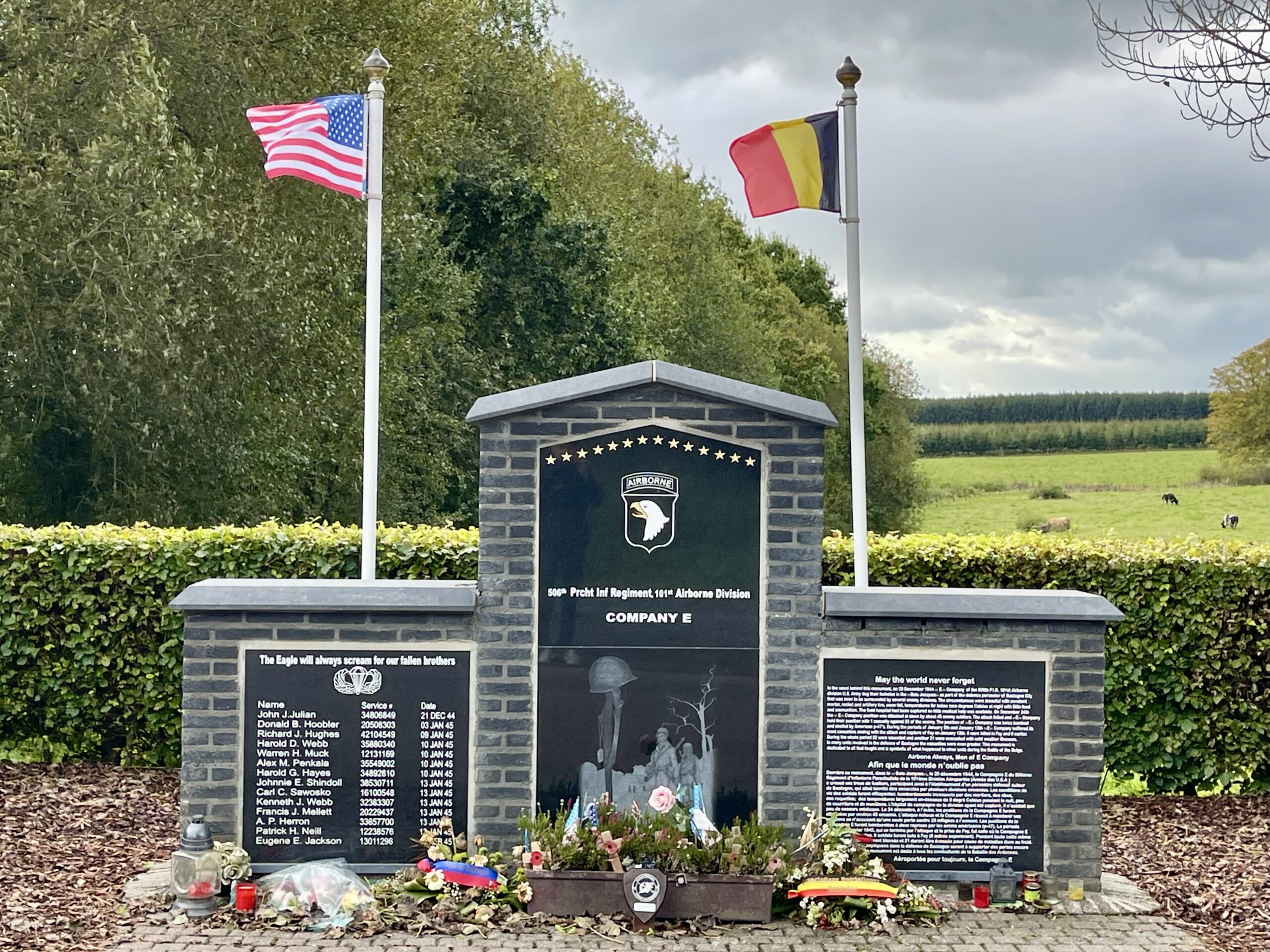
E Company, 101st Airborne Division memorial
Le Bois de la Paix (Woods of Peace) in the village of Bizory honours fallen US soldiers with small signposts and 4,000 types of trees as well as military divisions with plaques in the ground. Thousands of trees were planted in their honour by a local committee of UNICEF for the 50th anniversary of the Battle of the Bulge. Viewed from above, the trees form the shape of UNICEF’s emblem of mother and child. The woods also recognise via a panel and three trees the Martyred Cities of Peace, including Bastogne and nine other European cities.
Voie de la Liberté (Freedom Trail) marks every kilometre of 1,147 of the Allied forces’ route from the Normandy beaches in France on D-Day to Bastogne in December 1944. The last three markers are in Bastogne: next to the Sherman tank in Place McAuliffe (used by the 11th Armored Division during the Battle of the Bulge), outside Anim’Jeunes (Youth House) and the road leading to the Bastogne War Museum. Each red, white and blue marker shows the flaming torch of liberty emerging from the sea eastward and 48 stars representing the-then 48 United States.
The Nurses of Bastogne Memorial, a 2015 addition to the area’s commemorations, honours two ‘Angels of Bastogne’, Renée LeMaire and Augusta Chiwy, who volunteered to care for US soldiers during the Siege of Bastogne. Both worked in an aid station that was bombed on December 24, 1944. LeMaire and 30 soldiers were killed. A plaque commemorating them is on the site of the former aid station (now a large restaurant called Cite Wok) about a block from Place McAuliffe. Chiwy, who lived until 2015, is buried near Lemaire in the cemetery across the street from the Bastogne Barracks. Next to the nurses’ memorial is the turret of a tank used by the US 10th Armored Division’s Combat Command B, the first major unit to defend Bastogne.
The village of Recogne switched between American and German control during World War II so it was chosen as the burial place for both in 1945. But in 1948, the US soldiers were repatriated back home or transferred to other European burial sites. The Recogne German Military Cemetery remains with black stone crosses marking the graves of about 6,800 soldiers from the battle. Nearby is the Foy American Temporary Cemetery Memorial recognising the US soldiers who used to be buried there. Close to Recogne is another memorial honouring Native American soldiers who lost their lives during the battle (inaugurated for its 50th anniversary).
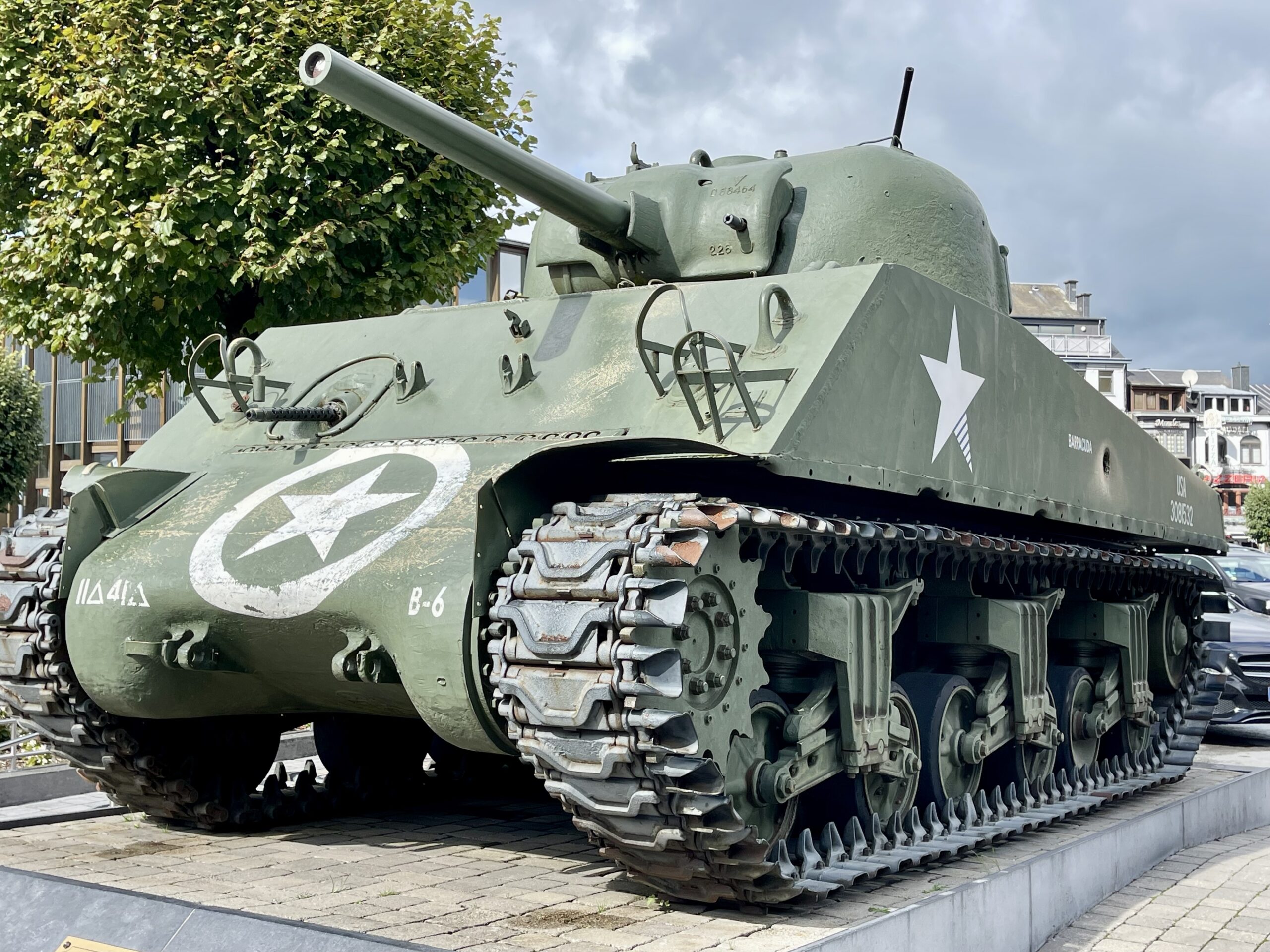
M4 Sherman tank in Place McAuliffe in Bastogne
The heavily damaged Foy Chapel, now restored, has a plaque recognising Alden Todd and Frank Marchese, soldiers of the 101st Airborne Division, who took an altar bell and bible, respectively, from the church during the war as spiritual souvenirs. Todd returned the bell in person in 1984 and Marchese, Jr. the bible on behalf of his father in 2024. The memorial monument recognises the US soldiers who participated in “unusually violent fighting” in nearby Jacques’ Woods. Across the street in Sargent Joseph Madona Square in an old house with damage from the war, including bullet holes.
Houmont Church has two memorials, a stained-glass window and a monument to honour of 11th Armored and 17th Airborne Divisions that liberated the village of Houmont in January 1945.
Beyond the battle
Port de Trèves, a square stone tower, is the last remaining piece of medieval fortifications that once surrounded the city. It was originally built as a gateway in 1332 but converted into a prison and temporary refuge in the late 1600s until World War I. It was almost destroyed during World War II but restored to its former glory afterwards in a symbolic victory.
The Piconrue Musée de la Grande Ardenne and House of Legends showcases religious heritage and folklore of the Ardennes from Catholicism to fairies, gnomes, werewolves and other creatures of the nocturnal forest. Outside is a large monument dedicated to Bastognians who resisted and died in the war. Near Place Piconrue is a stained glass window illustrating a herdsman taking pigs to an acorn field in honour of local farmers.
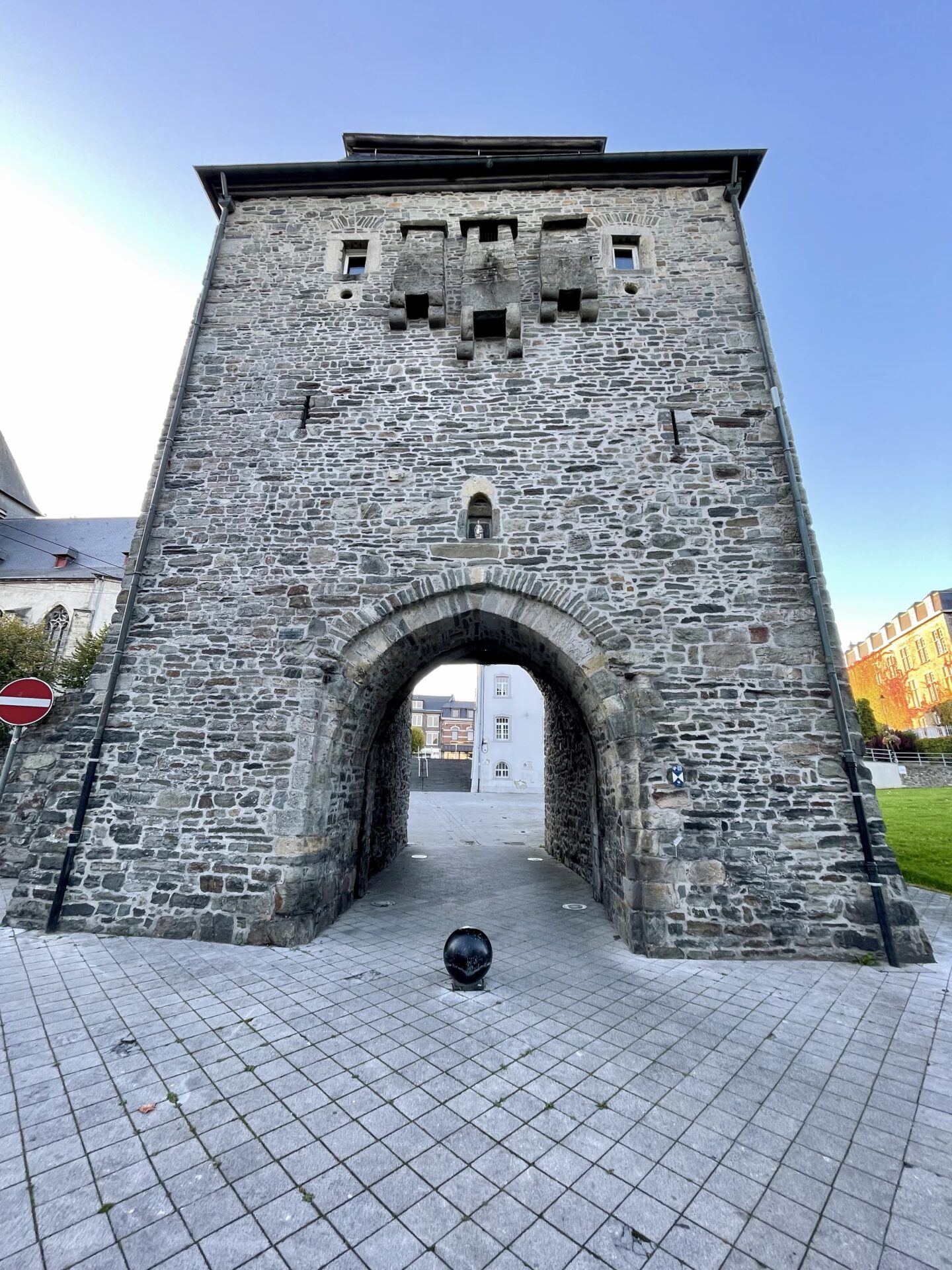
Port de Treves in Bastogne
L’Orangerie houses a contemporary art space and Centre Culturel Bastogne. On the main shopping street, Rue du Sablon, two fountains with small children crawling up represent rivalries between people from the upper and lower parts of Bastogne.
Église Saint-Pierre, dating to the 12th century, is known for an ornate ceiling, 18th century pulpit and moving sculpture of four soldiers outside of it (this area is also where the annual Christmas is held). Église Saint-Lambert in Rachamps is listed as heritage, largely because of its Romanesque tower and 18th century furniture.
Surrounding nature
For visitors seeking a break from the wartime reminders, there is stunning nature in and around Bastogne. For example, Parc Elisabeth has a rose garden, labyrinth, perimeter walk, water jets and fruit bushes. Bastogne-Tourisme.be offers 12 walking routes from 4.6 to 11.7km and five cycling routes from 20 to 38km. Belgian blue cows and deer are common sightings and one pedestrian trail even features a bison farm. The tourism office also has information about hiring electric, mountain bikes and riding behind a team of horses.

The Bois Jacques (Jack's Wood) in Foy
The Haute-Sure Foret d’Anlier Nature Reserve covers seven communes, including Bastogne, over 80,000 hectares. It contains Belgium's largest beech forest and six signposted walking routes, including the Legends Route with folklore from villages in the reserve. It also has four biking routes called Cyclolégendes between 35 and 65km.
Orti Nature Reserve in nearby Sainte-Ode is known for marshland, spruce trees, black storks and beavers. It features Le sentier (trail) de la Girolle, nearly 18km, which cuts through an orchard of apples and pears as well as an apiary supplying Orti Honey.
Liège-Bastogne-Liège is a 254.5km route in late April for avid cyclists with challenging hills and steep slopes. It was set up in 1892 by two Liège cycling groups, becoming an annual race with world champions like five-time winner Eddy Merckx (1969-1975) and Tadej Pogačar (2024). Today, it is known as La Doyenne (the oldest) cycling race of the classics. Sculptures in a roundabout near the Bastogne Nord bus station pay tribute to this famous cycling race.

Airborne beer, made in Bastogne
Tastes of the Ardennes
Jambon d'Ardenne (Ardennes ham), has a protected geographical indication (PGI) from the EU, and there is even a Confrérie des Herdiers d'Ardenne (Royal Brotherhood of Ardenne Herders) to uphold the appellation. Le Musée du Cochon by Ets Hartman et Fils and Boucherie Grégoire on Rue du Sablon offers a range of cured and smoked meats. Murielle Courtois and Claude Ligot Butcher-Caterer in the nearby villages of Marvie and Lavacherie, respectively, offer artisanal meats cured by traditional methods.
Bastogne also boasts several craft brews. Memory was created this year from American hops in commemorations of the 80th anniversary of the Battle of the Bulge. Other local beers include Airborne, Patton, Piche Cacaye de Bastogne (named after a folkloric character), La Vatch’ Hot, Kodacieuse, BR, La Cuvee de la Jonquille, La Troufette, La Corne (du Bois des Pendus) and Vapeur Cochonne. Some are sold at the Bastogne Tourism office and Bastogne War Museum. Other regional drinks include Nuts hazelnut liqueur, Le Petillant Ardennais sparkling apertif from Sainte-Ode and wines from La Cave du Roy in Neffe.
Lait P’Tits Plaisirs and Le Ferme d’Antan offer tastes of the Ardennes with homemade dairy products. The former sells yoghurts and cheese and Antan goat cheese by appointment. Le Rucher (Apiary) de Lutremange sells its own honey on site.
Local produce, snacks, flowers, textiles and more are sold every 15 days by about 100 merchants at the Foire aux Camelots (street fair) near Récollets football pitch. The next one is December 21.

